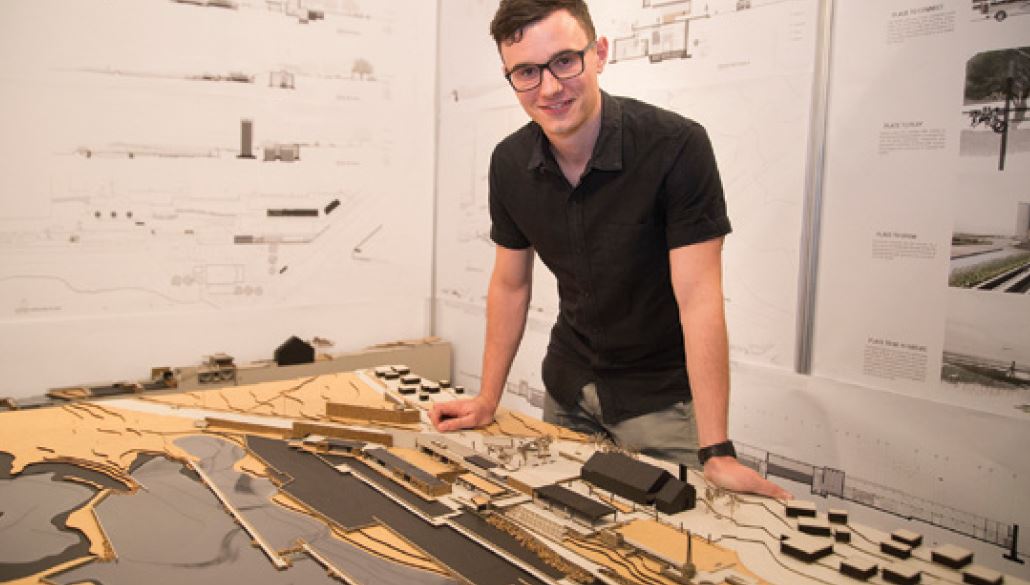“It doesn’t need to be like this; it cannot be like this today, and my design concentrates on decentralised 21st century sewage treatment facilities within our city, that looks to contribute to urban environments in creating better people spaces,” says architecture graduate Matthew Morris, who was the recipient of the Corobrik regional award in 2017 for his master’s project in the School of Architecture titled The design of a decentralised sewage treatment facility for a settlement within Bethelsdorp, Port Elizabeth.
Morris’s project addresses the ecological problem of degrading sewage infrastructure and pollution in the Swartkops River Valley system, the edges of which are settled by people from the highly populated urban area of northern Port Elizabeth. At the same time as proposing appropriate infrastructure, the design’s explicit architectural intent is to create healthier, greener living environments for the residents.
“It is about creating innovative service infrastructure to deal with the sewage and pollution but then to evolve past this strictly utilitarian function to restore healthy natural environments that edge attractive green spaces for the residents,” he explains.
“There are alternative, ecologically-based ways of treating sewage, that use far less energy compared to the traditional, chemically based sewage treatment approach in large treatment works that too easily deteriorate, creating peripheral derelict wastelands. The international leading-edge approach is to create several smaller sewage treatment plant nodes within cities and ensure they are optimally functional, and surrounded by attractive green people spaces, which are lacking in the overcrowded Northern Areas of Port Elizabeth.
“The treatment plant nodes therefore create enjoyable community spaces that begin to integrate infrastructure to create a layered and more valuable urban fabric. The architectural intervention I proposed was that the primary facility should be centred on an existing church edging the highly polluted Chatty River – a subsidiary of the Swartkops River; in fact the church was the starting point for the project, as churches and other religious centres, together with schools, are natural gathering places for communities,” Morris explains.
The scheme was set up within and throughout the Govan Mbeki ward or service area of Bethelsdorp. Morris divided Govan Mbeki into eight precincts, each with their own treatment plant nodes. “It creates a network of what I refer to as ‘interception nodes’ that can be extended beyond my primary project area into other areas of this community and wider contexts,” says Morris.
“The nodes can be developed as a continuously growing, wardscale network instead of the current municipal-scale facility, which is heavily polluting water sources such as the Swartkops estuary because of the degradation and overburdening of the system.
“With the multiple node sewage treatment system, the system is cost effective, it manages waste within communities closer to the source, and it limits the amount of waste overflowing into natural
systems, which is far more sustainable than constantly trying to clean up the waste. We can also use certain species of plants in the treatment process to revitalise the Swartkops ecosystem.”
The design integrates the urban, environmental and structural, with clever inclusions, such as places to play, catch taxis, gather, and embrace nature, as well as spaces for urban agriculture, where appropriately treated biomass supports rich, fertile growing conditions. The urban agriculture side helps to address the dire economic issues within the fabric of Bethelsdorp through the byproducts of the sewage treatment process, giving the facility a greater intrinsic value by layering the activities that contribute to the daily lives of the community.
Being a master’s submission, Morris’s design is a theoretical model but it exemplifies the thinking that should be applied to bring together people, quality of life and the environment in the Nelson Mandela Bay Municipality, where the natural habitat accounts for 62% of the metropole. As the metropolitan municipality with the highest proportion of natural landscape in the country, Nelson Mandela Bay presents itself as an ideal, best practice model for South Africa in the integration of the natural, social and infrastructural realms.
